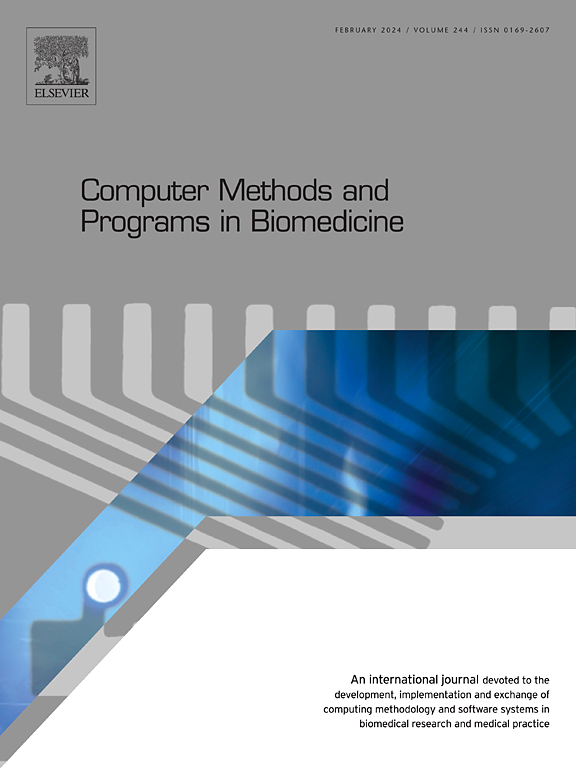Dual-modeling computational framework of magnetoelectric core-shell nanoparticles and nanochain for wireless peripheral nerve regeneration
IF 4.9
2区 医学
Q1 COMPUTER SCIENCE, INTERDISCIPLINARY APPLICATIONS
引用次数: 0
Abstract
Objective
This study introduces a novel dual-modeling computational framework to comprehensively analyze magnetoelectric CFO-BTO core-shell nanoparticles and nanochains for wireless peripheral nerve regeneration. Our approach covers both single-particle physics and tissue-level effects for wireless peripheral nerve regeneration applications, evaluating the capability to generate therapeutic electric fields (5–140 V/m).
Methods
We developed a two-step computational strategy: first, a detailed multi-physics model characterizing individual nanostructure magnetoelectric coupling, incorporating experimental parameters from literature; second, a tissue-level model analyzing electric field distributions in both 2D in-vitro and 3D in-vivo configurations, with varying magnetic stimulations and nanochain concentrations (0.5–5 % w/v).
Results
The magnetoelectric analysis revealed better performance in nanochains compared to single nanoparticles, with optimal results achieved using cylindrical shell geometry. The 3D in-vivo configurations demonstrated higher field values compared to 2D in-vitro configuration, with therapeutic levels achieved across significant tissue volumes at higher nanochain concentrations.
Conclusion
This computational analysis validates that magnetoelectric nanochains can generate therapeutically relevant electric fields for nerve regeneration through wireless magnetic stimulation.
Significance
This study provides the first computational framework that quantitatively predicts electric field distributions from magnetoelectric nanostructures in neural tissue, providing essential design guidelines for optimizing wireless nerve regeneration therapies and accelerating their translation to clinical applications.
磁电核壳纳米粒子和纳米链无线周围神经再生双建模计算框架
目的引入一种新的双模型计算框架,综合分析磁电CFO-BTO核壳纳米颗粒和纳米链对无线周围神经再生的影响。我们的方法涵盖了无线周围神经再生应用的单粒子物理和组织水平效应,评估了产生治疗性电场(5-140 V/m)的能力。方法采用两步计算策略:首先,结合文献中的实验参数,建立表征单个纳米结构磁电耦合的详细多物理场模型;其次,在不同的磁刺激和纳米链浓度(0.5 - 5% w/v)下,组织水平模型分析了二维体外和三维体内结构下的电场分布。结果纳米链结构的磁电分析结果表明,纳米链结构的磁电性能优于单纳米颗粒结构,其中圆柱壳结构的磁电性能最佳。与2D体外配置相比,3D体内配置显示出更高的场值,在更高的纳米链浓度下,在显著的组织体积上达到治疗水平。结论该计算分析验证了磁电纳米链可以通过无线磁刺激产生与神经再生相关的治疗电场。本研究提供了第一个定量预测神经组织中磁电纳米结构电场分布的计算框架,为优化无线神经再生疗法和加速其转化为临床应用提供了必要的设计指南。
本文章由计算机程序翻译,如有差异,请以英文原文为准。
求助全文
约1分钟内获得全文
求助全文
来源期刊

Computer methods and programs in biomedicine
工程技术-工程:生物医学
CiteScore
12.30
自引率
6.60%
发文量
601
审稿时长
135 days
期刊介绍:
To encourage the development of formal computing methods, and their application in biomedical research and medical practice, by illustration of fundamental principles in biomedical informatics research; to stimulate basic research into application software design; to report the state of research of biomedical information processing projects; to report new computer methodologies applied in biomedical areas; the eventual distribution of demonstrable software to avoid duplication of effort; to provide a forum for discussion and improvement of existing software; to optimize contact between national organizations and regional user groups by promoting an international exchange of information on formal methods, standards and software in biomedicine.
Computer Methods and Programs in Biomedicine covers computing methodology and software systems derived from computing science for implementation in all aspects of biomedical research and medical practice. It is designed to serve: biochemists; biologists; geneticists; immunologists; neuroscientists; pharmacologists; toxicologists; clinicians; epidemiologists; psychiatrists; psychologists; cardiologists; chemists; (radio)physicists; computer scientists; programmers and systems analysts; biomedical, clinical, electrical and other engineers; teachers of medical informatics and users of educational software.
 求助内容:
求助内容: 应助结果提醒方式:
应助结果提醒方式:


